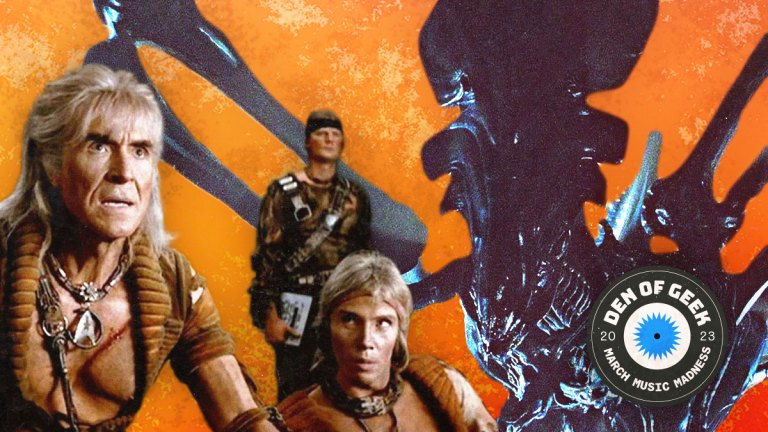The Strange Musical Connection Between Star Trek and Aliens
(Or: Remembering the time James Horner got honked off at James Cameron on Aliens but still rocked some great tunes... straight out of Star Trek.)

It’s fair to think that movie music is usually at its best when you don’t notice it playing in the background. The better composers know they shouldn’t overpower a scene; they enhance it. Yet there are times when the music should catch enough of our notice that it gives us hints about what’s going on, or what’s to come, mixing with the movie to turn a big moment into something even more memorable. This often overlaps with the use of leitmotif, a signature theme that associates itself with an individual or a recurrent situation, like the way John Williams’ “Imperial March” tells us Darth Vader is here, or that the Empire is up to something dreadful.
Music is too important a tool for filmmakers to ignore, even if the audience can. The right score can make a movie iconic, and the right leitmotif will make a character immortal. A good director knows this and works with their composer to make sure they’re working from as big of a final cut of the film as they can manage. This ensures the musicians have time to bring their best work to the table by reacting to what’s on the screen.
Of course sometimes that relationship can break down, yet even that doesn’t mean the end result will be a total disaster. Sometimes, in fact, a rushed remix does a job no one else could accomplish. Just ask James Horner and James Cameron. Stress, delays, and a messy production shattered the crucial relationship between film and music during the making of the now seminal Aliens (1986)—it also created a bizarre crossover between the xenomorphs and Star Trek’s mighty Klingon Empire, becoming its own kind of harmony in the process.
The Search for a New Score
At the time of his death in 2015, James Horner was one of Hollywood’s biggest composers. It’s hard to definitively say that he had a speciality in terms of genre; his compositions uplifted everything from heartbreaking dramas to Westerns. But he never left his horror and science fiction origins behind either. With his score for the cheesy Roger Corman sci-fi cheapie Battle Beyond the Stars turning into a mainstay for whenever Corman didn’t want to pay for new music, Horner got a reputation as a composer who gave great value. He had a gift for making budget action feel big with his signature horns and dramatic motifs.
As the second Star Trek film, The Wrath of Khan (1982), moved into production, Paramount Pictures knew it needed to dramatically cut the budget and amp the vivacity after the first film’s languid sail through the stars. Horner, then 28, was suggested on the strength of both his cheapie sci-fi success and his ear-catching score for the acclaimed werewolf horror film Wolfen (1981). His goal on Star Trek II was to avoid mimicking Jerry Goldsmith’s score for Star Trek: The Motion Picture, which he accomplished with a mix of nautical themes, some of which feel borrowed from Battle Beyond the Stars, and modernized homages to Alexander Courage’s original theme for the Star Trek TV series.
Horner’s success brought him back for Star Trek III: The Search for Spock (1984), which gave him an opportunity to create his own leitmotif for Trek’s iconic race of villains, the Klingons. Simply called “Klingons,” the musical composition is a six-minute mix that begins with gentle Star Trek chimes which are abruptly scattered by rhythmic percussion and a brass section evoking fantasy war horns. It’s a theme that borrows some of the same primal quality as Khan’s motif from the previous film, but is angrier and more feral in contrast to Goldsmith’s regal Klingon riff, heard early in The Motion Picture.
The Search for Spock would end Horner’s tenure with the franchise, but the films’ financial success kickstarted his career and he quickly became an in-demand composer across every major studio. That put him in the perfect position for his first Oscar nomination—and his worst nightmare—as 1986’s Aliens entered production.
James Cameron’s Countdown
A James Cameron movie set can be a rough ride, just ask his cast and crew. While they’re almost always quick to add that Cameron is right there with them during the worst of a film’s troubles, or happy to praise the end product, the journey is, repeatedly, hell. But Cameron’s tyrannical tendencies hadn’t yet come to the fore when he won the chance to helm his blockbuster follow-up to Ridley Scott’s Alien (1979). The few troubles on the set of Cameron’s The Terminator (1984) came down to budgetary issues and an initial hesitation by Cameron to cast Arnold Schwarzenegger in the titular role. It would be Aliens that first showed the world Cameron’s zealous and sometimes knife-edged side as a director.
Filming ended on time and on budget, despite Cameron’s persistent on-set conflicts with the English film crew, but the battle didn’t end there. Before Aliens, Horner and Cameron had crossed paths during their Corman years—this is your obligatory reminder that Cameron’s directorial debut was the schlock classic Piranha II: The Spawning (1981)—and Horner was prepared to have six weeks to work with Cameron and build their score for Aliens. Six weeks turned into three weeks, as Cameron didn’t have a rough build for Horner to work from. Post-production went into overtime, and three weeks turned into two.
The Wrath of Horner
The shortened schedule did nothing for Horner’s mood, nor his confidence in his own work. Those two weeks continued to be whittled down, with days lost and scores tossed aside due to changes in post-production. Major musical cues like the one that plays over Ripley’s epic mecha loader vs. the xenomorph kaiju Queen fight needed to be created overnight, thanks to Cameron’s constant recuts.
Crunched to his limits, Horner understandably began to remix and reuse whatever he could get away with to fill in the gaps, from the original Goldsmith score for Alien to his own previous work. Ugliest of all, once Horner had done what he could, Cameron, without Horner’s oversight, turned Horner’s compositions into a jigsaw puzzle, jamming it into the finished film however he thought best.
But let’s go back to that overnight kaiju battle theme. Called “Bishop’s Countdown” on the official soundtrack, it’s classic Horner. Metallic percussion and wailing horns create three minutes worth of pure tension. It’s instinctively familiar stuff, awakening our fears as Ripley fights to protect Newt. That’s not the only way it’s familiar, though. A dozing Star Trek fan with Aliens playing in the background of their home might jerk up as the theme starts, wondering why they’re hearing Klingons. That’s because… we pretty much are.
Anyone’s overnight cram sessions can bring out the best in us under duress, crystallizing our previous work into something new but accidentally familiar. Under James Horner, the attack of the Klingons had fully evolved into the terror of the xenomorphs.
Werewolves, Klingons, and Xenomorphs, Oh My!
But wait, there’s more! It’s ironic that Cameron has (more than once) talked about his conflict with Horner on Aliens, and blamed himself and his familiarity with Brad Feidel’s more easily changed-up synth score for The Terminator. Horner was no stranger to remixing his work to suit new requirements, and it’s part of what made his music so useful to Roger Corman, and, affectionately, there’s plenty of compilations on film score sites and forums that list all the times Horner has, um, plagiarized his own work.
But in the case of “Klingons” and “Bishop’s Countdown,” the pieces are in two different keys, and it’s difficult to verbally describe the audible similarity beyond their shared percussion and war horn crescendos. Let’s link two videos that show the sheet music, this one showing “Bishop’s Countdown” matched to its big scene, the latter, a piano arrangement for “Klingons” that, while adapted to protect the copyright on Horner’s original, still shows enough visual pattern similarity to catch the eye of anyone vaguely familiar with reading music.
A third piece of sheet music can be layered on these near-identical parallels, and that’s that werewolf movie that got Horner his Star Trek gig: Wolfen’s symphonic score, audible here at the 30 second mark on, also includes that same little tune we know from everything else we’ve already talked about—and dozens of movie trailers, besides. Say what we will about Horner’s tendency to remix his work, but he knew a good tune when he heard it.
His Scores Will Go On
Far unlike the easy friendship between Steven Spielberg and John Williams, Aliens would mark the first and last time Horner and Cameron would speak to each other for a decade. It took precise, almost Churchillian diplomacy on Cameron’s part to get Horner to speak with him about a project Cameron knew only Horner could bring to life. For Titanic (1997), it wasn’t about the naval themes Horner brought to Star Trek, or the rising action. Horner, in the interim, had created beautiful dramatic scores for Edward Zwick’s Glory (1989), Ron Howard’s Apollo 13 (1996), and Mel Gibson’s Braveheart (1995).
After an intercession by Randy Gerston, the music supervisor for Titanic, Horner agreed to meet with Cameron. After a long talk where the two men settled their disagreements over Aliens, Horner agreed to compose for him one more time. This time, the two were in sync, and it led to Horner also setting the tone for James Cameron’s Avatar (2009).
James Horner died in an accident in 2015 when his private aircraft crashed into a California forest. He is remembered by Cameron in the Avatar: The Way of Water credits, along with Aliens’ Bill Paxton. We remember him for giving both Klingons and xenomorphs the best, most chilling themes in movie history. Even if they’re, well, kind of the same theme.
